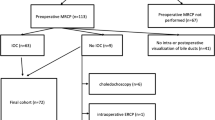Abstract
Background
Routine performance of intraoperative cholangiography (IOC) during cholecystectomy is controversial. The aim of this study was to evaluate the role of IOC during cholecystectomy in addition to preoperative magnetic resonance cholangiopancreatography (MRCP) in our institution over a 12-year period.
Methods
A total of 425 consecutive patients who underwent IOC during cholecystectomy were included in this study. MRCP was performed preoperatively for bile duct evaluation in all patients. When common bile duct (CBD) stones were detected, they were removed endoscopically before the operation. We estimated the results of IOC in terms of the success rate, the detection rate of anatomic abnormality of the biliary system, and the incidence of residual CBD stones.
Results
MRCP preoperatively identified 6 (1.4 %) patients with abnormal biliary systems and 56 with CBD stones, which were endoscopically removed. The success rate of IOC was 93.8 % (399/425). Abnormalities of the biliary system were detected in 12 patients (12/399, 3.0 %) and CBD stones in 8 (8/399, 2.0 %). Of the eight patients with stones, seven had been examined by endoscopy preoperatively and found to have CBD stones. The detection rate of bile duct stones in patients with preoperative endoscopic removal of CBD stones (7/56, 12.5 %) was significantly higher than those with CBD stones first detected during IOC (1/365, 0.3 %) (p < 0.01). Moreover, no residual CBD stones were detected in patients who were operated on within fewer than 12 days from endoscopic treatment to the operation.
Conclusions
IOC is indicated even after preoperative sphincterotomy for CBD stones. In our study, it resulted in a 12.5 % incidence of persistent stones after sphincterotomy. IOC plays an additional role in detecting CBD stones and in revealing abnormalities of the biliary tree in patients whose biliary tree was preoperatively evaluated by MRCP.

Similar content being viewed by others
References
Vagenas K, Karamanakos SN, Spyropoulos C et al (2006) Laparoscopic cholecystectomy: a report from a single center. World J Gastroenterol 12:3887–3890
Liu JJ, Alemozaffar M, McHome B et al (2008) Evaluation of real-time infrared intraoperative cholangiography in a porcine model. Surg Endosc 22:2659–2664
Metcalfe MS, Ong T, Bruening MH et al (2004) Is laparoscopic intraoperative cholangiogram a matter of routine? Am J Surg 187:475–481
Vecchio R, MacFadyen BV (2002) Laparoscopic common bile duct exploration. Langenbecks Arch Surg 387:45–54
Olsen D (1997) Bile duct injuries during laparoscopic cholecystectomy. Surg Endosc 1:133–138
Tan JT, Suyapto DR, Neo EL et al (2006) Prospective audit of laparoscopic cholecystectomy experience at a secondary referral centre in South Australia. ANZ J Surg 76:335–338
Caratozzolo E, Massani M, Recordare A et al (2004) Usefulness of both operative cholangiography and conversion to decrease major bile duct injuries laparoscopic cholecystectomy. J Hepatobiliary Pancreat Surg 11:171–175
Hamouda AH, Goh W, Mahmud S et al (2007) Intraoperative cholangiography facilitates simple transcystic clearance of ductal stones in units without expertise for laparoscopic bile duct surgery. Surg Endosc 21:955–959
Wenner DE, Whitwam P, Turner D et al (2005) Actual time required for dynamic fluoroscopic intraoperative cholangiography. JSLS 9:174–177
Polat FR, Abci I, Coskun I et al (2000) The importance of intraoperative cholangiography during laparoscopic cholecystectomy. JSLS 4:103–107
Palanivelu C (2007) Intraoperative cholangiography. In: Art of laparoscopic surgery: textbook and atlas. Jaypee Brothers Medical Publishers, New Delhi, pp 585–592
Barkun JS, Fried GM, Barkun AN et al (1993) Cholecystectomy without operative cholangiography: implications for common bile duct injury and retained common bile duct stones. Ann Surg 218:371–379
Lepner U, Grunthal V (2005) Intraoperative cholangiography can be safely omitted during laparoscopic cholecystectomy: a prospective study of 413 consecutive patients. Scand J Surg 94:197–200
Piacentini F, Perri S, Pietrangeli F et al (2003) Intraoperative cholangiography during laparoscopic cholecystectomy: selective or routine? G Chir 24:123–128 (in Italian)
Collins C, Maguire D, Ireland A et al (2004) A prospective study of common bile duct calculi in patients undergoing laparoscopic cholecystectomy: natural history of choledocholithiasis revisited. Ann Surg 239:28–33
Mir IS, Mohsin M, Kirmani O et al (2007) Is intra-operative cholangiography necessary during laparoscopic cholecystectomy? A multicentre rural experience from a developing world country. World J Gastroenterol 7:4493–4497
Philip WB, David JL (1997) Magnetic resonance cholangiopancreatography. Gut 41:135–137
Calvo MM, Bujanda L, Calderon A et al (2002) Role of magnetic resonance cholangiopancreatography in patients with suspected choledocholithiasis. Mayo Clin Proc 77:422–428
Cuschieri A, Shimi S, Banting S et al (1994) A. Intraoperative cholangiography during laparoscopic cholecystectomy: routine vs selective policy. Surg Endosc 8:302–305
Lezoche E, Paganini A, Guerrieri M et al (1994) Technique and results of routine dynamic cholangiography during 528 consecutive laparoscopic cholecystectomies. Surg Endosc 8:1443–1447
MacFadyen BV (2006) Intraoperative cholangiography: past, present, and future. Surg Endosc 20:43
Ludwig K, Bernhardt J, Steffen H et al (2002) Contribution of intraoperative cholangiography to incidence and outcome of common bile duct injuries during laparoscopic cholecystectomy. Surg Endosc 16:1098–1104
Kullman E, Borch K, Lindstrom E et al (1996) Value of routine intraoperative cholangiography in detecting aberrant bile ducts and bile duct injuries during laparoscopic cholecystectomy. Br J Surg 83:171–175
Ostroff JW, LaBerge JM (2002) Endoscopic and radiologic treatment of biliary disease. In: Feldman M, Friedman LS, Sleisenger MH (eds) Gastrointestinal and liver disease: pathophysiology, diagnosis, management, 7th edn. Saunders, Philadelphia, pp 1503–1535
Carroll BJ, Friedman RL, Liberman MA et al (1996) Routine cholangiography reduces sequelae of common bile duct injuries. Surg Endosc 10:1194–1197
Mah D, Wales P, Njere I et al (2004) Management of suspected common bile duct stones in children: role of selective intraoperative cholangiogram and endoscopic retrograde cholangiopancreatography. J Pediatr Surg 39:808–812
Author information
Authors and Affiliations
Corresponding author
Rights and permissions
About this article
Cite this article
Ueno, K., Ajiki, T., Sawa, H. et al. Role of Intraoperative Cholangiography in Patients Whose Biliary Tree Was Evaluated Preoperatively by Magnetic Resonance Cholangiopancreatography. World J Surg 36, 2661–2665 (2012). https://doi.org/10.1007/s00268-012-1715-9
Published:
Issue Date:
DOI: https://doi.org/10.1007/s00268-012-1715-9




